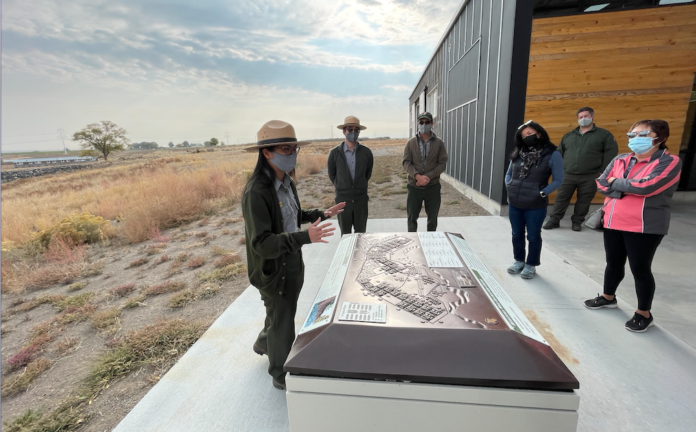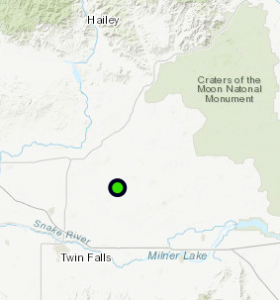
1,000-megawatt producing, 400 wind turbine proposal generates scrutiny
By Eric Valentine

Everybody likes the idea of green energy. Add windmills to that mix, and most folks still get images of Dutch landscapes, not goofy cancer-causing claims. But when a project for up to 400 wind turbines with a maximum height of 740 feet each—the Seattle Space Needle is 605 feet—is proposed in your neck of the woods, a different level of scrutiny typically kicks in and questions start blowing in the wind.
The Lava Ridge Wind Energy Project, as it’s called by the U.S. Department of the Interior, is proposed by Magic Valley Energy, a subsidiary of LS Power, which has developed significant renewable, transmission, and other energy projects across the U.S. It would be constructed on BLM-managed public land in southern Idaho, approximately 25 miles northeast of Twin Falls. It could generate 1,000 megawatts, which loosely translated means it could power up about 12,000 homes a year.
“Renewable wind projects are a critical component of the Biden-Harris administration’s commitment to confronting climate change, promoting clean air and water for our current and future generations, creating thousands of good-paying union jobs, and jump-starting our country’s transition to a clean energy future,” said Deb Haaland, the Biden Administration’s Secretary of Interior. “At the Interior Department, we are doing our part to ensure these projects are done thoughtfully and avoid impacts to surrounding communities.”
For Diana Nielson, a concerned citizen who lives southwest of the project and owns property in the area of impact, too, that impact to surrounding communities is flying under the radar. Nielson said her calls to attention had started to make headway, including interest from The Sean Hannity Show.
“And then the war in Ukraine broke out,” Nielson said.
Nielson is not anti-renewable energy, nor is she pro-fossil fuel. She does believe hydro power is the best alternative energy for Idaho, but has no particular stake in that industry. Among Nielson’s concerns is that wind energy solutions are not as “renewable” as they sound. According to the Environmental Protection Agency, a quality, modern wind turbine will generally last for 20 years.
“And they have no reclamation plan!” Nielson adds.
Although such a plan would have to come at some point in the future, that doesn’t allay Nielson’s concerns now which, among other things, include:
• Impact to fowl—wind turbines kill approximately 681,000 birds each year in the U.S. (American Bird Conservancy)
• Impact to fauna—the proposal area is a corridor for wildlife
• Impact to soil—batteries used in a wind turbine project affects soil quality
• Impact to hunting units
“Hailey and Ketchum like their dark skies. Where are the dark sky ordinance people on this?” Nielson asked.
She’s Not Alone
It may not feel like it to her, but Nielson is not alone in her concerns. Last fall, the Idaho Conservation League—which supports renewable energy overall—published a blog noting the impacts of a project like this. Some excerpts from the article by Dainee Gibson:
“Each wind turbine foundation would require around 21,600 gallons of water for the turbine foundations. The primary land use in the proposed project area is agriculture. It is important to consider the impact of this much water use on the local water supply, which is already limited. On the other hand, additional renewable energy projects will help mitigate carbon dioxide pollution that furthers climate change, which is currently causing droughts and water shortages throughout the region.
“Some of the wildlife that could be impacted by the project include pronghorn and mule deer, which migrate through the proposed project area and are especially reliant on the project area during the winter months.
“Another impact from the project: the wind turbines would be visible from Minidoka National Historic Site. Minidoka was one of the isolated internment sites that held unjustly relocated and incarcerated Japanese Americans during World War II.”
The Coalition To Protect America’s National Parks—a 2,000-member organization of retired, former, or current National Park Service employees—penned a scathing tome of a letter to Kasey Prestwich, the project manager for Lava Ridge. The group cites 12 core issues in its comments to the BLM and provides four areas in which they claim the BLM has failed in its management responsibilities. The group provides eight specific steps it expects the BLM to take.
Editor’s Note: For convenient links to these letters, articles, project descriptions and more, please check out this story online at WoodRiverWeekly.com
How to participate in the scoping process:
• Attend the virtual scoping meetings to learn more
about the project and ask questions.
• Visit the BLM’s project website https://go.usa.gov/xFKxg. Click on the “Participate Now” button to the right of the document link.
• Sign up for the project mailing list to receive project updates or submit comments by emailing: BLM_ID_LavaRidge@blm.gov
• Mail comments to: Kasey Prestwich, Project Manager, BLM
• Shoshone Field Office, 400 West F Street, Shoshone, ID 83352
• For more information regarding the public scoping meetings or the proposed project, contact Kasey Prestwich, phone 208-732-7204, email kprestwich@blm.gov.


